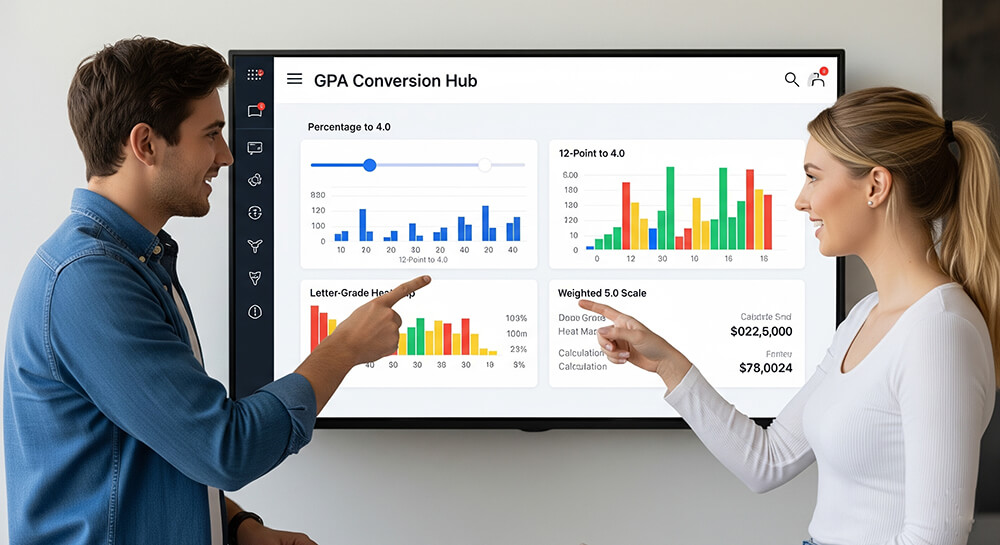Key Takeaways
| GPA Scale Type | How It Works | Who Uses It |
|---|---|---|
| Unweighted 4.0 Scale | The most common scale where an 'A' is 4.0 points, regardless of class difficulty. | Most U.S. high schools and colleges. |
| Weighted 5.0 Scale | Awards extra points for difficult classes like AP or Honors, allowing a GPA to exceed 4.0. An 'A' in an AP class can be worth 5.0 points. | Many high schools to reward academic rigor. |
| 12-Point Scale | A less common system where grades are assigned a point value up to 12 (for an A+). | Some universities, particularly in Canada. |
| Narrative Evaluations | Replaces traditional letter grades with detailed written feedback from professors. | A small number of liberal arts colleges like Hampshire College and Evergreen State College. |
The Standard: Unweighted 4.0 GPA Scale
Most schools in the United States use the unweighted 4.0 GPA scale. This system is simple. An 'A' grade equals 4.0 points, a 'B' is 3.0, and so on. The main feature of this scale is that all classes are treated the same. An 'A' in a beginner class has the same value as an 'A' in an advanced class. This makes it easy to understand a student's average grade. To figure out your GPA on this scale, you need a basic GPA formula guide. The difference between a weighted vs. unweighted GPA is a key concept for students to grasp.
Rewarding Effort: The Weighted 5.0 GPA Scale
Many high schools use a weighted GPA scale to recognize students who take harder classes. On this scale, an 'A' in a regular class is still a 4.0, but an 'A' in an Advanced Placement (AP) or Honors course can be worth 5.0 points. This system allows students to earn a GPA higher than 4.0. It helps colleges see which students challenged themselves with a more difficult course load. A 5-0 GPA scale guide can explain the specific point values. This is especially important for students in programs like the International Baccalaureate, who may need an IB to GPA conversion guide.
A Different Approach: The 12-Point GPA Scale
The 12-point GPA scale is less common in the U.S. but is used by some universities, especially in Canada. In this system, an A+ is worth 12 points, an A is 11, and so on. This allows for more detailed differences between letter grades. For students applying to schools that use a different system, a 12-point to 4-point scale chart is a necessary tool. It helps translate grades accurately. Understanding 12-point vs. 10-point GPA conversion is also useful for international applicants.
Beyond Numbers: Narrative and Mastery-Based Systems
Some colleges do not use traditional GPA scales at all. Schools like Hampshire College, Evergreen State College, and Alverno College use narrative evaluations. Instead of a letter grade, professors write detailed feedback on a student's performance and progress. Other schools use mastery-based or pass/fail systems. These focus on whether a student has mastered the required skills. Learning how pass-fail grades impact your GPA is important, as these courses are often treated differently by graduate schools and employers.
How Different Schools Calculate GPA
The way GPA is calculated can change from one place to another. Knowing how school districts calculate GPA helps students understand their high school transcript. When you move on to higher education, a college GPA calculator becomes an essential tool for tracking your progress. Even for younger students, a high school GPA calculator can provide clarity on their academic standing. Each institution has its own methods, making these specialized tools very helpful.
Why Converting Between Scales Is Important
With so many different grading systems, students often need to convert their grades from one scale to another. This is common when applying to colleges or for scholarships. Admissions offices need a standard way to compare applicants. Using GPA conversion charts and tools ensures that your academic record is understood correctly. A 4-0 vs 5-0 GPA outcome simulator can also show how your choice of courses might affect your GPA on different scales.
Tools to Help You Understand Your GPA
Figuring out your GPA doesn't have to be hard. Many online resources are available to help. A weighted vs. unweighted GPA calculator can show you both versions of your GPA. For tracking grades over time, a semester GPA calculator is useful. To see the big picture, a cumulative GPA calculator adds up all your grades from every semester. These tools remove the guesswork and help you stay on top of your academic performance.
The History Behind Different GPA Scales
Different GPA scales exist because educational ideas have changed over time. The simple 4.0 scale was created for uniformity, but the rise of advanced courses led to weighted systems. The history of GPA shows a move from simple letter grades to more complex systems that try to capture a student's full academic effort. Understanding the difference between quality points vs. GPA explained can also provide insight into how these calculations work.
Frequently Asked Questions (FAQ)
1. What is the most common GPA scale? The most common GPA scale in the U.S. is the unweighted 4.0 scale, where an 'A' is worth 4.0 points.
2. Why do some schools use a 5.0 GPA scale? Schools use a weighted 5.0 scale to give extra credit for advanced courses like AP, Honors, or IB. This rewards students for taking on more challenging coursework.
3. Are there schools that don't use GPA? Yes, some colleges, like Hampshire College and Evergreen State College, use narrative evaluations instead of traditional grades. They provide written feedback to assess student performance.
4. What is a 12-point GPA scale? The 12-point scale is another grading system, used by some universities, where an A+ is worth 12 points. It offers a more granular way to represent grades compared to the 4.0 scale.
5. How do colleges compare students from schools with different GPA scales? Colleges are familiar with the various GPA scales and often recalculate a student's GPA to a standard format for fair comparison. They also look at the rigor of the courses on a student's transcript.








